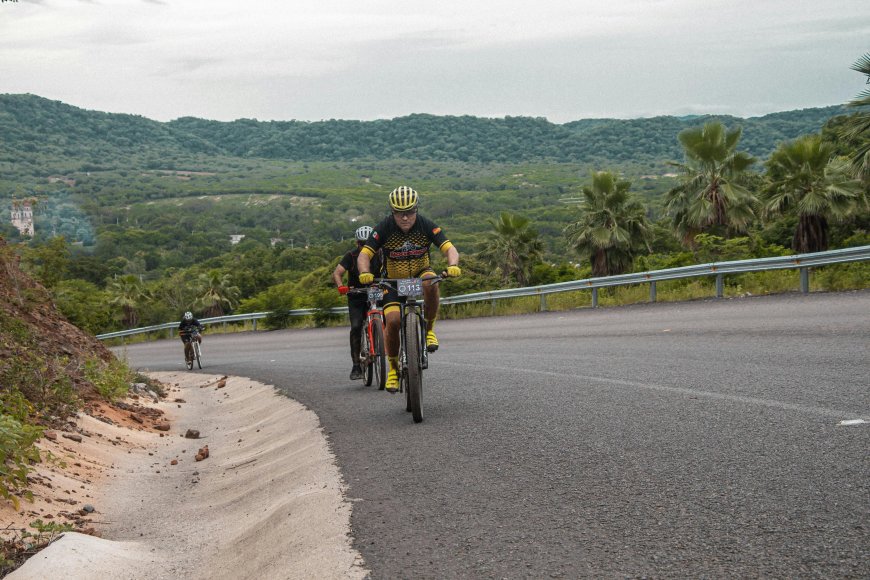Guidelines for Beginning Mountain Biking Practice
Get ready to explore the world of mountain biking by admiring the beauty of the nature surrounding you, and make sure to wear protective gear for your head and body. Check your bike and adjust its settings carefully, including tire pressure, brake functions, and gears. Before embarking on your journey, review the trail map and check the weather conditions. When setting off, be cautious and proceed slowly at first, using proper riding techniques to tackle rough terrains. Maintain your center of gravity and enjoy the challenges ahead, and don't forget to savor the breathtaking views and the wonderful experience that mountain biking offers.

Get ready to explore the world of mountain biking by admiring the beauty of the nature surrounding you, and make sure to wear protective gear for your head and body. Check your bike and adjust its settings carefully, including tire pressure, brake functions, and gears. Before embarking on your journey, review the trail map and check the weather conditions. When setting off, be cautious and proceed slowly at first, using proper riding techniques to tackle rough terrains. Maintain your center of gravity and enjoy the challenges ahead, and don't forget to savor the breathtaking views and the wonderful experience that mountain biking offers.
Guidelines for Beginning Mountain Biking Practice
A beginner's guide to mountain biking is a valuable resource for newcomers looking to explore the world of mountain biking and its challenges. This guide aims to lead beginners step by step through the process of preparation, planning, and execution of mountain biking trips in a safe and enjoyable manner.
The guide starts by providing an introduction to the benefits of mountain biking and its importance for health, fitness, and natural exploration. It also includes guidance on selecting the appropriate mountain bike, considering factors such as frame type and size, brake type, and suspension system.
Next, the guide moves on to instructions for preparing the bike for mountain rides, including adjusting settings such as tire pressure, gear tuning, and brakes. The guide also emphasizes the importance of wearing protective gear such as helmets, gloves, and armor for personal safety.
Furthermore, the guide offers tips on choosing suitable trails for mountain biking, including assessing difficulty levels, different terrains, and expected weather conditions. It also provides guidance on proper riding techniques and how to deal with various challenges that beginners may encounter during mountain rides.
The guide encourages beginners to enjoy the experience of mountain biking and explore nature responsibly and safely, while also encouraging them to evolve and improve their skills over time.
Tips and Guidance
1. Choosing the Right Bike: Before embarking on mountain biking, it's crucial to select a suitable bike that matches the type of trails you intend to ride. Consulting experts at specialized shops for advice on the best frame quality, size, and suspension system is recommended.
2. Proper Bike Preparation: Regularly inspect your bike before each ride and ensure that all parts are in good condition. Adjust bike settings such as tire pressure, brake system, and gears to ensure your safety while riding.
3. Wearing Protective Gear: Never underestimate the importance of wearing protective gear like helmets, gloves, and armor. These gears play a critical role in protecting you from injuries in case of accidents.
4. Choosing Suitable Trails: Identify trails that match your skill level and the level of difficulty you wish to experience. Start with easy trails and gradually increase the challenge as your skills develop.
5. Proper Riding Techniques: Learn proper riding techniques such as standing on the bike and using brakes correctly during sharp turns and rough descents.
6. Maintain Center of Gravity: Keep your weight balanced on the bike and maintain focus and attention while riding to avoid falls and injuries.
7. Exercise Caution and Environmental Awareness: Be cautious and mindful of your surroundings such as rocks, trees, and wildlife, and avoid risky maneuvers and hazardous situations.
8. Enjoying Nature: Don't forget to enjoy the beauty of nature surrounding you during mountain biking. Take breaks and savor the breathtaking scenery.
9. Continuous Improvement and Development: Regularly practice mountain biking to improve your skills and increase your ability to tackle challenges and enjoy mountain rides better.
10. Embrace Adventure: Consider each mountain biking trip as a new adventure and an opportunity to enjoy challenges and fun. Don't be afraid to try new trails and discover new places.
Choosing the Ideal Trail for Mountain Biking
Choosing the perfect trail for mountain biking is a crucial step to ensure an enjoyable and safe experience. Here are some details on this topic
1. Assessing Difficulty Level: You should start by selecting a trail that matches your level of experience and skills in mountain biking. If you're a beginner, choose simple and easy natural trails before moving on to more challenging ones.
2. Studying the Map and Descriptions: Study the available trail map and review the trail description and key locations along the way. Check the distance, elevation, and expected terrain to determine if the trail is suitable for you or not.
3. Consulting Experts and Local Guides: Consult experts in mountain biking or local tour providers for advice on trails suitable for your skill level and goals.
4. Equipment and Skill Requirements: Evaluate your technical and physical abilities and identify a trail that requires the equipment and skills you possess. Choose a trail that matches your current equipment and skill level.
5. Environmental Factors: Pay attention to environmental factors such as weather, terrain, and geographical nature of the area you choose for biking. Select the appropriate season and weather conditions for the chosen trail.
6. Enjoying the Scenery: Choose a trail that offers you the opportunity to enjoy breathtaking landscapes and unique scenery along the way. Remember that mountain biking is not just about physical and technical challenges, but also about enjoying the beauty of nature.
Safe riding techniques for mountain biking trips
Safe riding techniques in mountain biking are essential to ensure the rider's safety and reduce the risk of injuries during outdoor adventures. Here are detailed insights on this topic
1. Proper Body Positioning: Your body position should be balanced and centered on the bike. Keep your back straight and horizontal, with slight bends in your elbows and knees to absorb shocks and terrain changes.
2. Correct Brake Usage: Use the braking system appropriately to avoid skidding and control speed. Apply both front and rear brakes gently and gradually to avoid sudden braking that may lead to loss of control.
3. Handling Rough Terrain: When tackling rough terrain like rocks and roots, maintain your focus and keep your bike's movement steady. Choose paths that offer the best angle for bike passage and reduce the risk of slipping.
4. Speed Control Technique: Employ precise braking technique and control speed appropriately, especially on steep descents or sharp curves. Avoid sudden wheel locking and look for suitable stopping points.
5. Interacting with Environmental Factors: Be cautious of environmental factors such as weather, terrain, and trail conditions. Consider potential weather changes and adapt accordingly, being prepared to deal with arising challenges.
6. Communication within the Team: During group rides, communicate with your team and agree on signals and key words for communication, marking positions, and warning about hazards.
7. Enjoying Adventure Cautiously: Remember that mountain biking should be an enjoyable and thrilling experience, but it should be enjoyed with caution and awareness. Do not exceed your skills and capabilities, and do not risk safety for adventure.
Overcoming Challenges During Mountain Biking
Overcoming challenges during mountain biking requires specific skills and strategies to deal with the various obstacles you may encounter along the journey. Here are some detailed tips on how to overcome difficulties during mountain biking
1. Climbing Technique: When facing challenges in climbing rugged slopes, focus on maintaining your weight centered and use pedal strokes to assist in bearing weight and reducing fatigue on the legs.
2. Rotation Technique: During long climbs, alternate between sitting and standing positions to distribute pressure on the body and reduce fatigue and strain.
3. Speed Control Technique: When descending on rugged slopes, use the brakes cautiously and balance technique to maintain a suitable speed and control the bike on rough terrain.
4. Interacting with Terrain Technique: Learn how to interact with different terrains such as rocks, roots, and obstacles to avoid hazards and maintain balance and direction.
5. Bike Control in Descents Technique: When navigating steep descents, shift your weight backward and use both front and rear brakes cautiously to maintain balance and control.
6. Pre-planning: Estimate the trail and identify critical locations such as sharp turns or steep descents before reaching them, and plan a strategy to deal with them effectively.
7. Maintain Focus and Concentration: Keep your focus and attention on the trail and the surrounding environment to avoid accidents and injuries.
8. Breathing Control: Ensure regular and deep breathing to help reduce tension and increase energy while overcoming difficulties.
By applying these strategies and developing your skills, you can successfully overcome the challenges you face during mountain biking and enjoy a more fun and safe experience.
Enjoy nature
Enjoying nature while mountain biking is an integral part of this thrilling experience. Here are detailed tips on how to enjoy nature while mountain biking
1. Explore Breathtaking Landscapes: Explore enchanting natural areas and enjoy the stunning landscapes you encounter during your mountain biking journey. Appreciate the beauty of dense forests, lush green meadows, and stunning mountain peaks along the way.
2. Stop to Appreciate the Scenery: Don't hesitate to stop when you come across a beautiful natural sight. Take a break, soak in the tranquility surrounding you, and capture photos to preserve memories of your trip.
3. Connect with Wildlife: Enjoy watching the diverse wildlife living in the natural areas you pass through. You may be lucky to spot colorful birds or wild animals like deer or squirrels.
4. Explore Diverse Natural Trails: Experience multiple trails that take you through a variety of terrains and natural landscapes. Enjoy the diversity of nature, from dense forests to green meadows to snow-capped mountain peaks.
5. Listen to Natural Sounds: Enjoy the natural tranquility of nature and listen to soothing sounds such as bird songs and flowing rivers. These peaceful sounds add to the charm and beauty of the biking experience in nature.
6. Connect with the Natural Environment: Respecting the natural environment and contributing to its preservation is an essential part of the mountain biking experience. Make sure to leave the area you pass through clean and free of litter and follow local rules to preserve the natural environment.
By following these tips, you can fully enjoy nature while mountain biking and embark on an adventure-filled experience full of discoveries.
Mountain battle
Mountain battle represents a unique challenge and experience in the world of mountain biking, where riders must overcome rugged mountainous terrain and various technical challenges. Here are detailed insights into this battle
1. Conquering towering elevations: The challenge in mountain battle involves scaling towering heights, requiring riders to ascend mountain peaks through rugged trails and steep slopes.
2. Mastering rugged terrain: Riders in mountain battle face diverse and rugged terrains, such as large rocks, fallen trees, and rockslides, necessitating advanced technical skills and climbing techniques.
3. Speed and balance control: Riders must maintain balance and control their speed while descending rapidly through rugged slopes, considering factors like steep inclines and unstable terrains.
4. Weather challenges: Mountain battle also includes weather challenges like strong winds, heavy rains, and snow, adding an extra element of challenge for riders and requiring quick adaptation and bike control skills.
5. Overcoming natural obstacles: Riders must overcome various natural obstacles like fallen trees, flowing rivers, and muddy trails, utilizing proper riding techniques and making quick and smart decisions.
6. Physical and mental endurance: Mountain battle demands high physical and mental endurance, requiring riders to be well-prepared and mentally prepared to overcome the tough challenges they may encounter during the journey.
Ultimately, mountain battle represents a comprehensive challenge that requires courage, skill, and proper preparation, but it also offers an opportunity to enjoy adventures and immerse oneself in the beauty of nature and the grandeur of mountain landscapes.
Summary
If you're considering starting mountain biking, here are some important guidelines to begin safely and enjoyably. First, choose the right bike for the type of trails you want to explore. Then, make sure to properly equip your bike and wear protective gear such as a helmet and gloves. Assess the difficulty level of the trail and choose routes that suit your skills and physical ability. Enjoy nature and explore the stunning landscapes while biking, and don't forget to enjoy the adventure and gradually improve your mountain biking skills.
Sources
1. Jebalik Website This website provides a range of tips and guidance for beginner mountain bikers, including instructional videos and helpful articles.
2. Daragetk Website This website offers articles and tips on how to start mountain biking and how to choose the right bike.
3. Pinkbike Forum This forum is an online community where mountain biking enthusiasts gather, and you can find useful topics here about tips for beginners and personal experiences.
What's Your Reaction?
















































































































